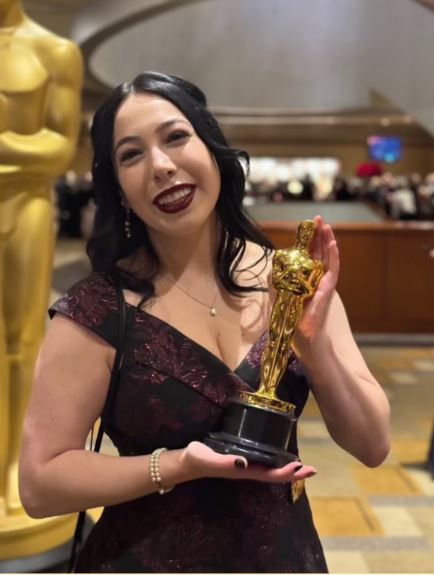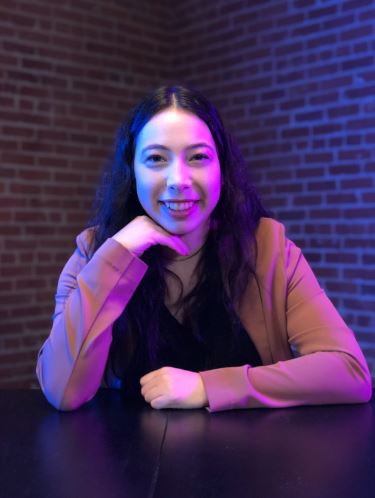Inside the Oscars: Lucy Rubin’s Award-Winning PR Campaign for “The Boy And The Heron”

I sat down with a PR professional in the film industry for an inside look into anime, awards campaigns and what it means to work in animation distribution.
*Editor’s Note: Staff Writer Grace Rubin is a cousin of Lucy Rubin.
“It was a moment I will remember for the rest of my life,” Lucy Rubin, the Director of PR for GKIDS Films animation, described her first time holding an Oscar for Hayao Miyazaki’s “The Boy and the Heron.” “Up until this year, GKIDS Films had had 12 nominations, 13 including ‘The Boy and The Heron’, and we kept calling this ‘Lucky 13.’ We really wanted to win it.” Despite Rubin being under 30, she has already worked on several award-winning films, attending both the Golden Globes and the Oscars. Although she now worships at the altar of her Peloton, Rubin expressed gratitude for her previous casual upper-body training for the ease with which she hoisted the 8.5 pound heft of solid bronze, plated in 24-karat gold, for the photo-op of a lifetime.
Rubin recalled the film’s premiere at the Toronto International Film Festival, where Guillermo del Toro introduced it. Rubin said del Toro equated living in a time when Hayao Miyazaki is making movies to living when Mozart was composing symphonies. She told me, “With a new film from this amazing director, it’s like the coming of a rare comet and to be able to work on it, never mind any awards, just to have the privilege of touching one of those films, was the professional honor of a lifetime.” Throughout the awards campaign, this thought was never far from her mind, and Guillermo del Toro’s words stuck with her after the Toronto premiere as the guiding light to help show Rubin, and the entire GKIDS Films team, the true scale of the project. “To see it come to that awards’ success was definitely the cherry on top, though,” Rubin confirmed with a reflexive smile.
Animated Feature Film was the third award announced on Oscars night, March 10, 2024. There were five films nominated: “Elemental,” “Nimona,” “Robot Dreams,” “Spider-Man: Across The Spider-Verse” and of course “The Boy and The Heron.” The award was announced by Chris Hemsworth and Anya Taylor-Joy. “The moment they said [the winner], all of us were sitting in a row and my heart was beating and I just heard ‘The Boy…’ and I nearly fainted. I just leaned back in my chair and I could not believe it. I was like, ‘There’s no way I’m going to faint in the Dolby right now.’” She went on to explain, “For GKIDS Films it felt not just like an award for one film, but an award for the development of a long, successful and prosperous relationship with Studio Ghibli. We were just so happy to be with them along that journey starting seven years ago when we first did our nationwide release of the Ghibli catalog.”

Riding the high of the success of “The Boy and The Heron,” it is pertinent to rewind for a moment to understand the journey that led her to this point. As a child, Rubin had been a fan of cartoons on Nickelodeon and the Toonami block on Cartoon Network, which served as her gateway into the world of anime. At Wesleyan University she decided to study film, given the prestige of the undergraduate program, which is not a production-based course, although there are required production classes. In Rubin’s words, Wesleyan’s theory is that “to be able to make a good movie, you have to be able to know what a good movie looks like, and how other people got to that point.” She then admitted, with a smile, that one of the reasons she loved that program was that she learned very quickly what a terrible director she was. Through the required production courses, Rubin described her experience in finding her preference for being in the driver’s seat. “I like being in A driver’s seat, just not THAT one,” she clarified. She was able to further develop her understanding of the depth of craft, particularly animation, and after an eloquent description, came to the conclusion that “it’s really freaking hard!”
Rubin continued to broaden her horizons at Wesleyan by taking classes in international cinema and particularly east Asian cinema, leading to Rubin taking Japanese classes. She laughed describing the extra credits she had to fill during her freshman year and thought Japanese would be an interesting language to learn. Although they posed a challenge, she ended up enjoying those studies so much that she added a double major of East Asian Studies to her film degree at Wesleyan. Her undergraduate experience included several study abroad programs, one of which included the US Department of State’s Critical Languages Scholarship.
Upon graduating from college, Rubin worked as an administrative assistant at a CPA firm. In her current role at GKIDS Films, she meets with film students and aspiring film careerists and uses this as an example of how one’s first job out of college need not be in one’s ideal industry. “You can basically do anything and turn that into a transferable skill,” she laughs when explaining the organization skills she honed while she searched for more permanent positions. Rubin was really hoping to land in New York, and was fortunate to find a position with a company called Film Circuits, an awards consulting agency. The idea of an awards consultant is that they take on a number of films each year and support the awards efforts. Some of the first films Rubin worked on while at Film Circuits were Matt Reeves’ “War for the Planet of the Apes,” Darren Aronofsky’s “Mother!” and Alexander Payne’s “Downsizing.” Each of these three films had its own unique challenges for an awards campaign and required particular strategizing. For example, the target was a VFX campaign for “War for the Planet of the Apes,” whereas for “Mother!” the campaign was focused on acting awards’ categories.

This job is where Rubin got her first experience with awards campaigning and premieres, which is ultimately what she would go on to do for GKIDS Films, and still feels grateful for that intense but valuable experience with Film Circuits. Enter: GKIDS Films. During all of this, they were still a fledgling company and had just started their own festival called Animation is Film, based in Los Angeles, which was the first exclusively animation-focused film festival in the United States. Rubin read about the festival on Variety, a co-sponsor of the event, and reached out to a friend from Wesleyan who worked for GKIDS Films. She had previously interned for the Boston Jewish Film Festival and was eager to get into the animation industry. Lucky for Rubin, GKIDS Films needed the help with the festival, and she was able to accept the internship while still working for Film Circuits.
With unabashed pride, Rubin recounted to me the opening night film from the first Animation is Film Festival. It was “The Breadwinner” from studio Cartoon Saloon directed by Nora Twomey, which went on to earn an Oscar nomination before ultimately losing to “Coco” in 2018. GKIDS Films was still a small company when Rubin began as a full-time employee, reminiscing about the team of fewer than ten other full-time employees with whom she would eat lunch. “I remember we could all sit at one round table for lunch,” she told me with a chuckle. “So lunch was a big deal. We really had a family-style lunch. But that’s what I loved about the company. I’ve been with GKIDS for seven years now and it’s always still maintained that indie feel. Everyone genuinely knows and cares about each other. We kibbitz, I really enjoy that.”

GKIDS Films takes a 360 boutique approach to each film. “With a smaller company, we’re able to really stay nimble in how we release a film. We’re able to consider the scope of each release, and the key marketing materials that are going to make that release appealing to the right audiences.” Once GKIDS Films agrees to take on a film, the process moves forward and the distribution company handles all materials associated with that film and its release in the US. That includes everything from trailers, the English dub, theatrical releases, festival placements, awards campaigns, advertising, press tours with the director and more. Rubin emphasized that, despite being a less understood side of film, animation distribution touches almost every corner of the industry. In 2011, GKIDS Films announced its acquisition of the North American theatrical distribution rights to the Studio Ghibli library, which were previously held by Walt Disney Studios Motion Pictures, an impressive feat for a relatively small distribution company, but one that has cultivated close personal relationships and profits for both GKIDS and Ghibli.
As the Director of PR, Rubin’s schedule is busy to say the least. Her days begin with checking her email, something she continues to do throughout the remainder of her day. By nature of working with people in many different time zones, Rubin explained that she often receives emails outside of typical New York business hours that need to be responded to promptly, and also finds she can sometimes catch Japanese colleagues before bed if she logs on first thing in the morning. Her meetings during the day range from strategizing sessions with the marketing team about current film releases, to upper management meetings about new film acquisitions, to brainstorming with outside publicity agencies about press solicitations. All interspersed with emails ad nauseam. Every day Rubin still makes time, despite her executive level promotion last year, for a check-in with her intern. A special mentality at GKIDS Films is the philosophy around their intern program. It is essential to the company that the interns are enjoying their work while also being useful and developing important skills to build their resume, given that so many current employees (including Rubin herself) started at GKIDS Films as interns. I was impressed when Rubin explained, “We want to be somebody’s foot in the door,” given the fabled gatekeeping mindset of some elites in the film industry.

As someone without any relevant background knowledge, I took some time to ask Rubin about the differences between American animation and traditional Japanese anime, and why she believes it is important to make anime available to a wider audience. She explained that most feature animation in the United States comes from major studios, which means they have enormous funding available to work with, films spend a long time in development and there is a greater level of executive oversight on the projects. The confluence of such factors create films that are exceedingly commercially minded, perhaps due to the prevailing idea in the US that animation must be for a family audience and must therefore hit a PG rating. Outside of the US market, animation ends up having more freedom of direction because filmmakers do not subscribe to the understanding that families are the target audience. In Japan, anime is so popular within mainstream culture that filmmakers create the same target markets we have in the West for live action films, but they do so all within the space of animation. So, even with smaller budgets, the range of artistic freedom to explore and push boundaries remains vital to the industry’s integrity.
With GKIDS Films as a US-based company focusing mostly on distributing international films, Rubin spoke to the value of making foreign films more widely available in the US. When voicing the challenges faced by filmmakers in other countries Rubin articulated, “There are so many different European productions that have a breadth of voices involved and you can get such different storytelling, when you’re keeping those challenges in mind. And everybody benefits from seeing films from other perspectives.” There has recently been talk about US animation having found itself in somewhat of a slump, and Rubin emphasized the benefit of audiences broadening their horizons by seeing animation created outside the US market. She asked the following three questions to frame her thought process and help others begin a similar discussion: “What makes a family film? What makes a ‘not family’ film? Would you be interested in watching something that’s a more adult-oriented film in the animated medium?” Rubin explained that asking these questions can help embolden US studios to take more risks in what has become a risk averse market. “To see that taking those risks can lead to critical acclaim, success and profitability, I think that’s really important for the industry at large.”

Understanding the depth of creative and logistical work that goes into making a film means appreciating the viewing experience much more deeply than the average filmgoer. When one applies this understanding to animation, particularly with the works of filmmakers like Hayao Miyazaki, the enjoyment of the cinematic artform grows exponentially. I hope that hearing the background experience of someone like Rubin can help the average filmgoer deepen their appreciation of their viewing experience, even a small amount. Considering that her journey in this industry only began 11 years ago, when she decided to pursue film and East Asian studies at Wesleyan University, it is truly remarkable that Rubin has already led a winning awards campaign for Best Animated Feature. It is only a matter of time until Lucy Rubin sets the publicity world on fire with another anime masterpiece, but until then, she is using her winning moment as inspiration: “You know, you grow up watching the Oscars and seeing the statue, and I’d say most people in America are familiar with what an Oscar looks like, and it’s so different when that thing is in your fucking hands, and it’s heavy and it’s there, and you’ve earned it. There is no feeling like holding an Oscar.”
